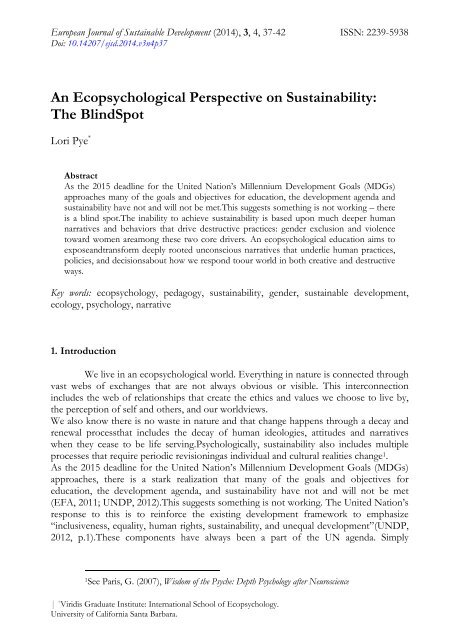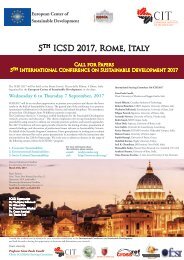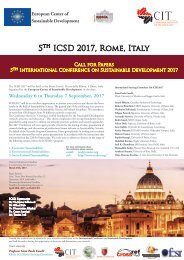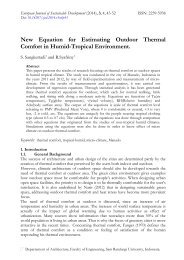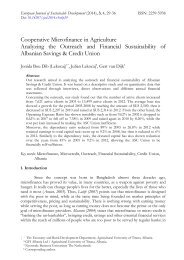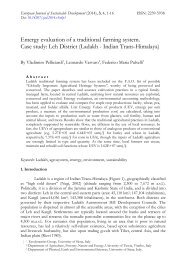An Ecopsychological Perspective on Sustainability: The BlindSpot
As the 2015 deadline for the United Nation’s Millennium Development Goals (MDGs) approaches many of the goals and objectives for education, the development agenda and sustainability have not and will not be met.This suggests something is not working – there is a blind spot.The inability to achieve sustainability is based upon much deeper human narratives and behaviors that drive destructive practices: gender exclusion and violence toward women areamong these two core drivers. An ecopsychological education aims to exposeandtransform deeply rooted unconscious narratives that underlie human practices, policies, and decisionsabout how we respond toour world in both creative and destructive ways. Key words: ecopsychology, pedagogy, sustainability, gender, sustainable development, ecology, psychology, narrative
As the 2015 deadline for the United Nation’s Millennium Development Goals (MDGs) approaches many of the goals and objectives for education, the development agenda and
sustainability have not and will not be met.This suggests something is not working – there is a blind spot.The inability to achieve sustainability is based upon much deeper human
narratives and behaviors that drive destructive practices: gender exclusion and violence toward women areamong these two core drivers. An ecopsychological education aims to exposeandtransform deeply rooted unconscious narratives that underlie human practices, policies, and decisionsabout how we respond toour world in both creative and destructive
ways.
Key words: ecopsychology, pedagogy, sustainability, gender, sustainable development, ecology, psychology, narrative
You also want an ePaper? Increase the reach of your titles
YUMPU automatically turns print PDFs into web optimized ePapers that Google loves.
European Journal of Sustainable Development (2014), 3, 4, 37-42 ISSN: 2239-5938<br />
Doi: 10.14207/ejsd.2014.v3n4p37<br />
<str<strong>on</strong>g>An</str<strong>on</strong>g> <str<strong>on</strong>g>Ecopsychological</str<strong>on</strong>g> <str<strong>on</strong>g>Perspective</str<strong>on</strong>g> <strong>on</strong> <strong>Sustainability</strong>:<br />
<strong>The</strong> <strong>BlindSpot</strong><br />
Lori Pye *<br />
Abstract<br />
As the 2015 deadline for the United Nati<strong>on</strong>’s Millennium Development Goals (MDGs)<br />
approaches many of the goals and objectives for educati<strong>on</strong>, the development agenda and<br />
sustainability have not and will not be met.This suggests something is not working – there<br />
is a blind spot.<strong>The</strong> inability to achieve sustainability is based up<strong>on</strong> much deeper human<br />
narratives and behaviors that drive destructive practices: gender exclusi<strong>on</strong> and violence<br />
toward women aream<strong>on</strong>g these two core drivers. <str<strong>on</strong>g>An</str<strong>on</strong>g> ecopsychological educati<strong>on</strong> aims to<br />
exposeandtransform deeply rooted unc<strong>on</strong>scious narratives that underlie human practices,<br />
policies, and decisi<strong>on</strong>sabout how we resp<strong>on</strong>d toour world in both creative and destructive<br />
ways.<br />
Key words: ecopsychology, pedagogy, sustainability, gender, sustainable development,<br />
ecology, psychology, narrative<br />
1. Introducti<strong>on</strong><br />
We live in an ecopsychological world. Everything in nature is c<strong>on</strong>nected through<br />
vast webs of exchanges that are not always obvious or visible. This interc<strong>on</strong>necti<strong>on</strong><br />
includes the web of relati<strong>on</strong>ships that create the ethics and values we choose to live by,<br />
the percepti<strong>on</strong> of self and others, and our worldviews.<br />
We also know there is no waste in nature and that change happens through a decay and<br />
renewal processthat includes the decay of human ideologies, attitudes and narratives<br />
when they cease to be life serving.Psychologically, sustainability also includes multiple<br />
processes that require periodic revisi<strong>on</strong>ingas individual and cultural realities change 1 .<br />
As the 2015 deadline for the United Nati<strong>on</strong>’s Millennium Development Goals (MDGs)<br />
approaches, there is a stark realizati<strong>on</strong> that many of the goals and objectives for<br />
educati<strong>on</strong>, the development agenda, and sustainability have not and will not be met<br />
(EFA, 2011; UNDP, 2012).This suggests something is not working. <strong>The</strong> United Nati<strong>on</strong>’s<br />
resp<strong>on</strong>se to this is to reinforce the existing development framework to emphasize<br />
“inclusiveness, equality, human rights, sustainability, and unequal development”(UNDP,<br />
2012, p.1).<strong>The</strong>se comp<strong>on</strong>ents have always been a part of the UN agenda. Simply<br />
1 See Paris, G. (2007), Wisdom of the Psyche: Depth Psychology after Neuroscience<br />
| * Viridis Graduate Institute: Internati<strong>on</strong>al School of Ecopsychology.<br />
University of California Santa Barbara.
38 European Journal of Sustainable Development (2014), 3, 4, 37-42<br />
emphasizing them does not solve the problem as to what is not working. In fact, this<br />
furthers an inherent ineffectiveness.<br />
2. <strong>The</strong> human issue<br />
Research across regi<strong>on</strong>s and countries has shownthat sustainable development<br />
programs and approaches that do not promote gender equality and the full participati<strong>on</strong><br />
of women and girls will not succeed (UNDP, 2012, p.1).Research has also shown<br />
linkages between gender inequality, poverty and envir<strong>on</strong>mental degradati<strong>on</strong> (EGI, 2013).<br />
In the last fifteen years theUN and many of its bodies have promoted and funded many<br />
gender equality strategies and programs in support of development and envir<strong>on</strong>mental<br />
sustainability (UNESCO, 2014). Yet we are no closer to achieving equality than we are to<br />
sustainable development. What are we not seeing - what is the blindspot here<br />
“Sustainable” is more than a development, ec<strong>on</strong>omic, or envir<strong>on</strong>mental issue; it is a<br />
psychological issuethat requires an ecopsychological approach. Failure to achieve<br />
sustainability is based up<strong>on</strong> much deeper human narratives and behaviors that drive<br />
destructive practices affectinghow we live. What we are not seeing is that “the<br />
psychology of the individual is reflected in the psychology of the culture, of nati<strong>on</strong>s, and<br />
in our world’s complex issues” (C.G. Jung, 1953, p.4).<str<strong>on</strong>g>An</str<strong>on</strong>g> ecopsychological pedagogy is<br />
designed to teach how to recognize psychological patterns within systems, and how to<br />
mature those relati<strong>on</strong>ships.<br />
<strong>The</strong> majority of post-2015 UN statements regardinggoals and objects for development,<br />
social, envir<strong>on</strong>mental and ec<strong>on</strong>omic sustainability now all highlight gender equality<br />
(UNESCO 2014). However, thisis where the blindspot resides.To focus <strong>on</strong> gender<br />
equality is a soft way of addressing the real issue.<strong>The</strong> blind spot we fail to see, recognize,<br />
or want to deal with isgender exclusi<strong>on</strong> and violence toward women. This is the core problem<br />
and underpins our incapacity to achieve sustainability in any form. Jimmy Carter (2014),<br />
former President of the United States, calls the violence toward women and girls, “the<br />
most serious and unaddressed worldwide challenge”(p.3). Christine Lagarde, Managing<br />
Director of the Internati<strong>on</strong>al M<strong>on</strong>etary Fund, called gender exclusi<strong>on</strong> aproblem for<br />
humanity (2013).Why are we not putting our focus and directing resources toward this<br />
issueTo achieve gender equality, gender exclusi<strong>on</strong> must first be eradicated and violence<br />
toward girls and women in all forms ended.<br />
Gender exclusi<strong>on</strong> and violence toward women are based <strong>on</strong> hierarchic modes of<br />
thinking,whichare not new. <strong>The</strong>se issues are being acknowledged by ec<strong>on</strong>omists, political<br />
scientists, researchers, historians, envir<strong>on</strong>mental scientists, and forward thinking global<br />
leaders, precisely because theyfoster ec<strong>on</strong>omic, envir<strong>on</strong>mentaland social instability and<br />
are an affr<strong>on</strong>t to all humanity.<strong>The</strong>se behaviors arebased up<strong>on</strong>dysfuncti<strong>on</strong>al and injurious<br />
narratives that c<strong>on</strong>stellate hierarchism and reducti<strong>on</strong>ism, preventing diversity and cultural<br />
evoluti<strong>on</strong>.It is impossible forthe United Nati<strong>on</strong>s and its bodies to ensure that<br />
“globalizati<strong>on</strong> becomes a positive force for all the world’s peoples,”(UNDP, 2012, p.1)<br />
when half of the world’spopulati<strong>on</strong> is not included due to discriminating laws, archaic<br />
social practices and the cultural acceptance of such.<br />
Gender exclusi<strong>on</strong>, ecological destructi<strong>on</strong> and c<strong>on</strong>tinued “microaggressi<strong>on</strong>toward<br />
women” (Huds<strong>on</strong>, Ballif-Spanvill, Caprioli, and Emmett, 2014, p. 17) are inc<strong>on</strong>sistant<br />
Published by ECSDEV, Via deiFiori, 34, 00172, Rome, Italy<br />
http://ecsdev.org
Lori Pye 39<br />
with life.<strong>The</strong>y take many forms, including soul violence of all sorts, lack of access to<br />
educati<strong>on</strong>, health care and ec<strong>on</strong>omic markets; exclusi<strong>on</strong> from participati<strong>on</strong> in societal<br />
decisi<strong>on</strong> making councils; and lack of equity in family law (Huds<strong>on</strong> et al, 2014).Indeed,<br />
there is a c<strong>on</strong>tinued exclusi<strong>on</strong> of womenfrom participati<strong>on</strong> in envir<strong>on</strong>mental issues and<br />
c<strong>on</strong>cerns in which women are deeplyinvested (Envir<strong>on</strong>ment and Gender Index, 2013).<br />
How these denigrating practices translate into the global culture is striking:<br />
• Women make up half of the world's populati<strong>on</strong>, yet represent a staggering 70%<br />
of the world's poorliving <strong>on</strong> less than $1 a day (Internati<strong>on</strong>al Labor Organizati<strong>on</strong>, 2003);<br />
• Women do two-thirds of the world's work, produce half of the world's food, but<br />
earn <strong>on</strong>ly 10% of the world's income, and own less than <strong>on</strong>e percent of the world's<br />
property 2 ;<br />
• 100 to 140 milli<strong>on</strong> girls and women around the world have underg<strong>on</strong>e genital<br />
mutilati<strong>on</strong>, including 6.5 milli<strong>on</strong> in Western countries. <strong>The</strong> majority of countries rarely<br />
engage in this practice. However, countries where more than half of the women have<br />
their genitals cut include Saudi Arabia, Ind<strong>on</strong>esia and Egypt (WomenStats Project,<br />
2011a)<br />
• In developing countrieswhereforced adolescent marriagesis comm<strong>on</strong>a girl or a<br />
woman dies every minute in giving birth.Marriage under the age of 18 has been<br />
correlated with higher rates of dying young, health problems, living in poverty and<br />
illiteracy. Countries in which underage marriage is comm<strong>on</strong> and encouraged include<br />
India, Turkey, and Panama, am<strong>on</strong>g many others (WomenStats Project, 2011b);<br />
• <strong>The</strong> countries that have more than 300 maternal deaths per 100,000 live births<br />
include almost all of central Africa, Pakistan and Bolivia(WomenStats Project, 2010a);<br />
• <strong>The</strong> countries in which women lack physical security (physical security defined<br />
as- “fewer laws against domestic violence, rape, and marital rape, their enforcement, the<br />
taboos or norms about reporting the crimes and existence of 'h<strong>on</strong>or killings') include<br />
Cambodia, Morocco and Peru, am<strong>on</strong>g many others in Africa and the Middle<br />
East(WomenStats Project, 2009, 2011c);<br />
• Violence and trafficking of girls and women is still legal in many countries and<br />
practiced widely around the world. <strong>The</strong> countries in which trafficking is not illegal and<br />
comm<strong>on</strong>ly practiced include Myanmar, Venezuela and North Korea. Studies have found<br />
2This data is drawn from organizati<strong>on</strong>s that collect and aggregate informati<strong>on</strong> at a global level,<br />
including the U.N. Millennium Campaign, the World Bank, UNESCO, and Populati<strong>on</strong> Fund. Sec<strong>on</strong>dary<br />
informati<strong>on</strong> retrieved 23June 2014 from http://www.womensfundingnetwork.org<br />
© 2014 <strong>The</strong> Authors. Journal Compilati<strong>on</strong> © 2014 European Center of Sustainable Development.
40 European Journal of Sustainable Development (2014), 3, 4, 37-42<br />
that 70 per cent of trafficked women end up in the sex trade(WomenStats Project,<br />
2011d);<br />
• Countries in which 0 to <strong>on</strong>ly 10 per cent of parliament is composed of women<br />
include China, Japan and Brazil. Research has found that achieving a critical mass of <strong>on</strong>ethird<br />
of women in government can help societies move bey<strong>on</strong>d gender-centric issues.<br />
(WomenStats Project, 2010b)<br />
Some of the most sobering statistics show that there is no country or nati<strong>on</strong> where<br />
women are physically secure (WomenStats Project, 2011e). Research has also shown “the<br />
best predictor of a state’s peacefulness is its level of violence against women. Even<br />
am<strong>on</strong>g democracies,those with poor physical security for women are less peaceful than<br />
democracies with good physical security for women (Huds<strong>on</strong> et al, 2012, p. 205; Carter,<br />
2014).<br />
In 1997, UNIFEM estimated that the m<strong>on</strong>etary value ofthe unpaid labor of women<br />
translated into around 40% of the world’s gross product (WGP) (Huds<strong>on</strong> et al, 2014,<br />
p.14).It is hard to believe that half the populati<strong>on</strong> has been left out of the<br />
officialcalculati<strong>on</strong> of GNP. In her opening speech at the World Ec<strong>on</strong>omic<br />
Forum,Christine Lagardeemphasized str<strong>on</strong>ger inclusi<strong>on</strong>, and a shared ec<strong>on</strong>omic<br />
prosperity when she stated:<br />
“All studies point to the ec<strong>on</strong>omic benefits of full female participati<strong>on</strong> in the labor force,<br />
in the ec<strong>on</strong>omy, in society. One recent study estimates that by simply raising women’s<br />
employment rates to the level of men, GDP would jump significantly - by 5 percent in<br />
the United States, 9 percent in Japan, 10 percent in South Africa, 27 percent in India, and<br />
34 percent in Egypt.” (2013)<br />
This is not a promoti<strong>on</strong> of unsustainable growth, but rather it is a promoti<strong>on</strong> of equity in<br />
ec<strong>on</strong>omic value. It is now widely acknowledgedthat the exclusi<strong>on</strong> of women’s labor,<br />
violence toward women, and barring womenfrom participati<strong>on</strong>in decisi<strong>on</strong> making<br />
processes are detrimental to the ec<strong>on</strong>omic, envir<strong>on</strong>mental and social systems. Yet, laws<br />
and policies are still in place around the world that hold these practices in place.<br />
<strong>The</strong> questi<strong>on</strong>s seem obvious: Why are we not insisting <strong>on</strong> an end to violence toward<br />
women and girls around the world Why c<strong>on</strong>tinue to fund countries, nati<strong>on</strong>s, policies,<br />
and strategies that not <strong>on</strong>ly exclude women, but c<strong>on</strong>sciously or unc<strong>on</strong>sciously perpetuate<br />
violence toward them How might these practices be finding cover under a sustainable<br />
development umbrella<br />
C<strong>on</strong>clusi<strong>on</strong>s<br />
If there are no ethical c<strong>on</strong>siderati<strong>on</strong>s within sustainable development, then<br />
deeper problems are easily camouflaged with “engaging rhetoric or superficial<br />
agreements” (Rolst<strong>on</strong>, 2012, p. 37). Development that reduces equality, exchange and<br />
distributi<strong>on</strong> of resources, plurality, ec<strong>on</strong>omic fairness, biodiversity, and enables violence<br />
toward women is what Vedana Shiva calls “maldevelopment” (1989, p.5).<br />
Published by ECSDEV, Via deiFiori, 34, 00172, Rome, Italy<br />
http://ecsdev.org
Lori Pye 41<br />
Maldevelopment inhibits ec<strong>on</strong>omic, envir<strong>on</strong>mental, social and cultural<br />
flourishing.Sustainable development can no l<strong>on</strong>ger not invest in girls and women.<br />
We cannot achieve equality or sustainability in our culture or nati<strong>on</strong>s unless we develop it<br />
in our psychologies. We create our reality, order our world, imagine our cosmology and<br />
develop our narratives based up<strong>on</strong> the structures dominant in our cultures. <str<strong>on</strong>g>An</str<strong>on</strong>g><br />
ecopsychological approach is essential to the task of initiatingchanges in our individual as<br />
well as in our cultural stories.<strong>The</strong> human psyche is cultural and cultures evolve like all<br />
ecosystems. Ecopsychology offers ways to track change and set priorities; it can offer<br />
new narratives for a sustainable future.<br />
<strong>The</strong> C<strong>on</strong>venti<strong>on</strong> <strong>on</strong> the Eliminati<strong>on</strong> of all Forms of Discriminati<strong>on</strong> against Women<br />
(CEDAW) is known as “the bill of rights for women’s equality” (Carter, 2014, p. 180). It<br />
defines what c<strong>on</strong>stitutes discriminati<strong>on</strong> against women and sets up an agenda for<br />
nati<strong>on</strong>al acti<strong>on</strong> to end such discriminati<strong>on</strong>. By accepting the C<strong>on</strong>venti<strong>on</strong>, states commit<br />
themselves to undertake a series of measures to end discriminati<strong>on</strong> against women in all<br />
forms (UN Womenwatch, 2014).However, it has been observed that “unless a right is<br />
said to expressly bel<strong>on</strong>g to women, it may not in fact be assumed to do so” (Huds<strong>on</strong> et<br />
al, 2012, p.123). CEDAW was adopted in 1979 by the UN General Assembly to address<br />
this problem.<br />
However, research has exposed lack of truthfulness and accuracy in reporting<br />
compliance. Although nati<strong>on</strong>s sign the C<strong>on</strong>venti<strong>on</strong>, there is too oftenlittle intenti<strong>on</strong> or<br />
acti<strong>on</strong> toward h<strong>on</strong>oring it. (Huds<strong>on</strong> et al, 2012, p.124; Carter 2014). CEDAW has been<br />
ratified by all nati<strong>on</strong>s except Iran, Palau, Somalia, Sudan, and T<strong>on</strong>ga. Embarrassingly, the<br />
United States, signed the treaty in 1980, but has not ratified it. This is due to the<br />
oppositi<strong>on</strong> of c<strong>on</strong>servative groups and the religious right who promote the same<br />
attitudes of ignorance and inequality that we see in countries openly allowing violence<br />
toward women and gender exclusi<strong>on</strong>.<br />
Biologist E. O. Wils<strong>on</strong> has commented that we are not the most numerous species <strong>on</strong><br />
the planet, but we are the most destructive. “<strong>The</strong> human c<strong>on</strong>diti<strong>on</strong> is an endemic turmoil<br />
rooted in the evoluti<strong>on</strong> process that created us. <strong>The</strong> worst in our nature coexists with the<br />
best…” (2012, p. 56). <strong>The</strong> narratives that hold in place destructive behaviors and<br />
practices toward the envir<strong>on</strong>ment and toward women are dangerously unc<strong>on</strong>scious.<br />
<strong>The</strong>y represent ecopsychological issues that profoundly affect our world.<br />
Achieving sustainability across social, ec<strong>on</strong>omic and envir<strong>on</strong>mental sectorsmust be led<br />
by educati<strong>on</strong>al efforts. Where educati<strong>on</strong> leads, development will follow. Ecopsychology<br />
is essential to creating a new framework for sustainable developmentthat servesthe<br />
complexities of both an ecological and a psychological world.<br />
References<br />
Carter, Jimmy. (2014). A call to acti<strong>on</strong>: Women, religi<strong>on</strong>, violence, and power. New York:<br />
Sim<strong>on</strong> & Schuster.<br />
Educati<strong>on</strong> for All (EFA). (2011). Global M<strong>on</strong>itoring Report -Teaching and learning: Achieving<br />
quality for all. Paris: UNESCO.<br />
Envir<strong>on</strong>ment and Gender Index (EGI). (2013).Pilot report. Washingt<strong>on</strong>, DC: IUCN<br />
Huds<strong>on</strong>, V., Ballif-Spanvill, B., Caprioli, M., & Emmett, C.F. (2012). Sex and world peace. New York:<br />
Columbia University Press.<br />
© 2014 <strong>The</strong> Authors. Journal Compilati<strong>on</strong> © 2014 European Center of Sustainable Development.
42 European Journal of Sustainable Development (2014), 3, 4, 37-42<br />
Internati<strong>on</strong>al Labor Organizati<strong>on</strong>.(2003). Facts <strong>on</strong> women at work. Geneva, Switzerland.<br />
Retrieved from http://www.ilo.org/wcmsp5/groups/public/---dgreports/<br />
dcomm/documents/publicati<strong>on</strong>/wcms_067595.pdf.<br />
Jung, C.G. (1953). Two essays <strong>on</strong> analytical psychology, CW, Vol. 7 (Gerhard<br />
Adler (Translator), R. F.C. Hull (Translator). New York: Bollingen Foundati<strong>on</strong>, Inc.<br />
Lagarde, Christine. (2013). World Ec<strong>on</strong>omic Forum Address. Davos, Switzerland.<br />
Paris, G. (2007). Wisdom of the psyche: Depth psychology after neuroscience. New York:<br />
Routledge.<br />
Rolst<strong>on</strong>, Holmes, III. (2012). A new envir<strong>on</strong>mental ethics: the next millennium for life <strong>on</strong> earth.<br />
New York: Routledge.<br />
Shiva, Vendana (1989). Staying alive: Women, ecology and development. New Delhi, India.<br />
United Nati<strong>on</strong>s Development Program (UNDP). (2012). Powerful synergies: Gender equality,<br />
ec<strong>on</strong>omic development and envir<strong>on</strong>mental sustainability. New York:UNDP.<br />
United Nati<strong>on</strong>s Educati<strong>on</strong>, Scientific and Cultural Organizati<strong>on</strong> (UNESCO). (2014). Priority<br />
gender equality acti<strong>on</strong> plan 2014-2021.Paris: UNESCO.<br />
Wils<strong>on</strong>, E.O. (2012). Social c<strong>on</strong>quest of the earth. New York: W.W. Nort<strong>on</strong>/Liveright Pub.<br />
WomenStats Project. [Map]. (2009). Women’s physical security. Retrieved from<br />
http://womanstats.org/newmapspage.html.<br />
WomenStats Project. [Map]. (2010a). Maternal mortality rate. Retrieved from<br />
http://womanstats.org/newmapspage.html.<br />
WomenStats Project. [Map]. (2010b). Government participati<strong>on</strong> by women.Retrieved from<br />
http://womanstats.org/newmapspage.html.<br />
WomenStats Project. [Map]. (2011a).Prevalence of female genital cutting. Retrieved from<br />
http://womanstats.org/newmapspage.html.<br />
WomenStats Project. [Map]. (2011b).Practice of child marriage for girls and Laws c<strong>on</strong>cerning<br />
child marriage for girls. Retrieved from http://womanstats.org/newmapspage.html.<br />
WomenStats Project. [Map]. (2011c). Prevalence of rape, Inclusivity of<br />
laws c<strong>on</strong>cerning rape, and Rate of murder of women. Retrieved from<br />
http://womanstats.org/newmapspage.html<br />
WomenStats Project. [Map]. (2011d).Trafficking of women,Retrieved from<br />
http://womanstats.org/newmapspage.html<br />
WomenStats Project. [Map]. (2011e).Combined scale of the prevalence and sancti<strong>on</strong> of rape and<br />
sexual assault of women. Retrieved from http://womanstats.org/newmapspage.html<br />
Published by ECSDEV, Via deiFiori, 34, 00172, Rome, Italy<br />
http://ecsdev.org


